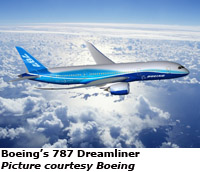Boeing 787 Dreamliner uses spectrometer to evaluate composite structures
03/11/2011
 Agilent Technologies Inc has announced that the Agilent 4100 ExoScan hand-held Fourier transform infrared spectrometer was added to Boeing’s new 787 Dreamliner service repair manual for its ability to evaluate the thermal exposure of the aircraft’s composite elements.
Agilent Technologies Inc has announced that the Agilent 4100 ExoScan hand-held Fourier transform infrared spectrometer was added to Boeing’s new 787 Dreamliner service repair manual for its ability to evaluate the thermal exposure of the aircraft’s composite elements.The fuselage, wings and other major components of Boeing’s much-anticipated 787 Dreamliner are constructed of an advanced carbon-fibre composite, requiring new non-destructive methods to inspect for potential damage. Following multi-year studies, the Agilent 4100 ExoScan was found to be an ideal instrument to measure the degree of thermal exposure on the fuselage and other carbon-fibre components.
“The 4100 ExoScan system continues to create new opportunities for FTIR spectroscopy in applications where the system must be used in demanding out-of-lab situations,” said Philip Binns, Agilent Vice President for spectroscopy products. “With the expanding use of composite materials in the aerospace industry, we are pleased that the ExoScan FTIR system can make a meaningful contribution to efficient manufacturing and maintenance of aircraft.”
The ExoScan FTIR system, which has the performance and sample interface required to successfully analyse carbon-fibre composites, is an example of how analytical instrumentation is increasingly utilised in out-of-the-lab applications. To qualify the system for use on aircraft, engineers carried out extensive comparisons using the hand-held FTIR technology and more traditional lab-based methods, including destructive, thermal and mechanical tests.
The ExoScan is used in many other in-the-field applications as well, such as materials analysis, art object conservation and geosciences. For those analysts who need a lab-based system now, and a hand-held system for occasional or future work, the ExoScan is available with a docking station that makes it a very effective bench-top FTIR.
www.chem.agilent.com